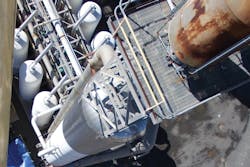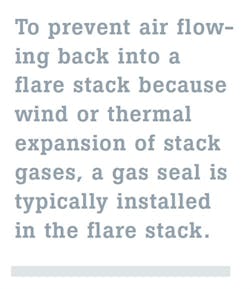Editor’s note: Part 1 of this article focused on safe control and operation of flare gas systems. Read it here.
At too high an exit velocity, the flame can lift off the tip and flame out; whereas at too low a velocity, it can burn back into the tip or down the sides of the flare stack. An optimal speed range should be specified and maintained. For safety reasons, a flare stack is used to elevate the flare. The flare should be located so that it does not present a hazard to surrounding personnel and facilities. Elevated flares can be self-supported (free-standing), guyed or structurally supported by a derrick. Self-supporting flares are generally used for lower flare tower heights (say 15 to 30 meters [m]) but can be designed for above 40-m elevations as well. Derrick towers are most often designed for above 40 m; guy towers are usually designed for more than 45 m. Free-standing flares provide ideal structural support. However, for tall units, the costs increase rapidly. In addition, the foundation required and nature of the soil should be considered.
Derrick-supported flares can be built as high as required since the system load is spread over the derrick structure. This flare design provides for differential expansion between the stack, piping and derrick. Derrick-supported flares are usually the most expensive design for a given flare height. The guy-supported flare is most often the simplest and least expensive of all support methods. However, a considerable amount of land is required since the guy wires are widely spread apart. A rule of thumb for space required to erect a guy-supported flare is a circle on the ground with a radius equal to the height of the flare stack.
Air may tend to flow back into a flare stack because of wind or the thermal contraction of stack gases, creating potential for explosion. To prevent this, a gas seal is typically installed in the flare stack. One type of gas seal (also referred to as a flare seal, stack seal, labyrinth seal or gas barrier) is located below the flare tip to impede the flow of air back into the flare gas network. Seals act as orifices in the top of the stack to reduce the purge gas volume for a given velocity. They also interfere with the passage of air down the stack from the upper rim. These modern seal systems are known by the names internal gas seal, fluidic seal and arrestor seal. These seals are usually proprietary in design, and their presence reduces the operating purge gas requirements.
Nozzle loads are imposed on the stack by the flare-header-to-stack connection and can have a major influence on the design and cost of the flare stack or the flare system. This influence increases as the elevation of the flare-header increases. Many flare stacks use expansion joints at their nozzles, but these expansion joints are expensive and maintenance-intensive. In general, the flare stack itself should not be used as a fixed anchor point for the flare-header piping. The flare headers are large-size piping and the temperature difference between different operating scenarios and various ambient conditions could be high since sometimes hot gases might be flared and other times, high-pressure gas inventories could be flared, which can generate low-temperature gases at blowdown (they might cool the flare system to very low temperatures, such as -40°C or less). In other words, some of the relief-gas cases can have a gas temperature that is significantly different from ambient. Flare piping designers should minimize the nozzle loads imposed on the stack by carefully designing the whole system.
The flare-stack should accommodate thermal expansion and contraction that can be caused by a specified gas temperature or by temperature differences caused by wind or rain. Thermal loads are of greatest concern on guyed stacks and derricks. Special attention should be given to the design of stacks in which the stack wall temperature is expected to be 155°C or higher. The same is true when the gas temperature is expected to be -45°C or lower. A hot stack wall, cooled on one side by wind (or a combination of wind and rain) bends, inducing additional loads on the stack, guy wires or derrick and foundations. Counter-measures may include shielding or insulating of the stack. However, these solutions are not popular. The freedom of movement of a self-supported stack reduces the thermal load considerations.
Flare tips
A flare tip is designed to give environmentally acceptable combustion of the vent gas over the flare system’s capacity range. The tips are under severe thermal and mechanical loads and they are normally proprietary in design. The objective of burners is to reliably light the flare burner and maintain stable combustion throughout the full range of process conditions, including under severe weather conditions, without the requirement for maintenance for many years of operation. Failures of flare tips have been reported. Modern flare tips are expensive pieces of equipment fabricated from sophisticated alloys, advanced stainless steel, super alloys, or other materials and designed after many simulations and optimizations.
Considerations should be given to flame stability, ignition reliability and noise suppression. The maximum and minimum capacity of a flare to burn a flared gas with a stable flame (preferably smokeless) is mainly a function of flare tip design. Flame stability can be enhanced by different advanced methods such as flame holder retention devices incorporated in the flare tip inner circumference. Burner tips with modern flame holders designs can have a stable flame over a wide flare gas exit velocity range. In other words, in modern flare systems, the actual maximum capacity of a flare tip is usually limited by the vent stream pressure available to overcome the system pressure drop and not the flare stack or tip. As an indication, elevated flare diameters are normally sized to provide vapor velocities at maximum throughput of about 40 percent of the sonic velocity of the gas subject to the constraints.
A diffusion flame receives its combustion oxygen by the diffusion of air into the flame from the surrounding atmosphere. The high volume of fuel flow in a flare may require more combustion air at a faster rate than simple gas diffusion can supply. Proper considerations should be respected for this factor, and suitable flare tip design should be selected.
Steam injection is often used in flares. High-velocity steam injection nozzles usually are positioned around the outer perimeter of the flare tip; they increase gas turbulence in the flame boundary zones, drawing in more combustion air and improving combustion efficiency. For large flares, steam can also be injected concentrically into the flare tip. The injection of steam into a flare flame can produce other results in addition to air entrainment and turbulence. Different mechanisms and theories in which steam reduces smoke formation have been presented. Briefly, one theory suggests that steam separates the hydrocarbon molecule, thereby minimizing polymerization, and forms oxygen compounds that burn at a reduced rate and temperature unconducive to cracking and polymerization.
Flare control
Flare system control can be completely automated or completely manual. Components of a flare system that can be controlled automatically include the auxiliary gas, the ignition system and steam injection (if steam is used). Fuel gas consumption can be minimized by continuously measuring the vent gas’s low rate, its heat content and automatically adjusting the amount of auxiliary fuel to maintain the required minimum total gas. Automatic ignition panels sense the presence of a flame with visual temperature measurements or thermal sensors and reignite the pilots when flameouts occur.
Automatic control based on flare gas flow, flame radiation or other methods such as observing the flare by camera or thermal imaging are effective for modern flares. Even the steam flow (for steam injected flares) can be controlled in this way to maintain smokeless operation, which can give a faster response to the need for steam and a better adjustment of the quantity required. To optimize steam usage, infrared sensors are also available that sense flare flame characteristics and adjust the steam flow rate automatically to maintain smokeless operation. Steam consumption can be properly minimized by controlling flow based on vent gas flow rate or visual smoke monitors.
Amin Almasi is a senior rotating machinery and equipment consultant. He is a chartered professional engineer of Engineers Australia and IMechE. Almasi is an active member of Engineers Australia, IMechE, ASME and SPE and has authored more than 100 papers and articles dealing with rotating equipment, condition monitoring, offshore, subsea and reliability.




